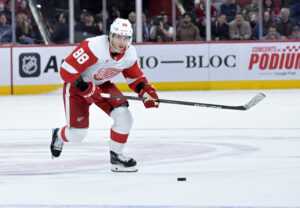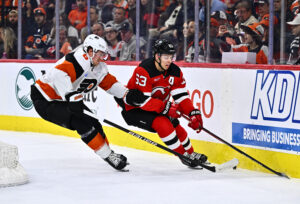Owen Power, Luke Hughes and Aidan Hreschuk are notable defensemen playing in the NCAA or USHL this season. Another name that needs more recognition is Sean Behrens. The left-handed, undersized defenseman deserves more recognition for what he has provided his teams this season. Here is what he can bring to the table for whichever team elects to draft him in July.
Sean Behrens Prospect Deep Dive
What The Experts Are Saying
Paul Zuk of Smaht Scouting: “Behrens is without a doubt a solid offensive defenseman prospect. There are countless things to like about his game, both offensively and defensively. Behrens may benefit the best from landing with a team who views him as the perfect fit for a larger, more defensive-minded partner. That potential pairing will allow Behrens to utilize his offensive abilities without hesitation. However, there are of course a few areas of his game which could use some work, if he’s to develop into a top-4 NHL defenseman at some point down the road.”
Hadi Kalakeche of Dobber Prospects: “His game is anticipation-based, and he shows the tools required to make it as a defenseman at higher levels. His stock should see an increase over the next few weeks, leading into the upcoming draft.”
Gabriel Foley, formerly of Last Word: “Behrens really likes long stretches of possession. He loves carrying the puck from the goal-line to the blue line, and making a nifty pass or dump-in… That’s why I’ve been saying I see shades of Adam Fox.”
Sean Behrens Profile
Behrens, born March 31st, 2003, is a left-handed defenseman, as mentioned earlier. Standing at 5’10” and 176 pounds, the Barrington, IL native has been ranked all over draft boards. He’s been ranked as early as 22nd by Elite Prospects and as late as 57th by Bob McKenzie. Meanwhile, I have Behrens ranked 23rd in the 2021 draft class. Despite his notable smaller stature, Behrens found success in the USHL, scoring four goals and adding 14 assists for 18 points in 23 games with the USNTDP. In the U18 World Juniors with Team USA, who shockingly didn’t medal, Behrens recorded four points in five games.
Skating Abilities
Sean Behrens is a good skater. While he isn’t great, and not the best skater on the ice, he does have good strides. He shows good knee and ankle flexion. He keeps his knees bent and gets low to generate power in his strides. His knees are parallel to his toes as well, showing good ankle flexion. Behrens also shows strong stride extension, kicking his legs back and showing an overall powerful stride. Not only does he display power in his stride technique, but he also shows his power through his balance and edges. Several times throughout the USHL season and World Juniors, Behrens held off attackers while maintaining puck control.
Behrens is also a smooth skater. Very agile, especially when possessing the puck. He can be deceptive and change direction without losing speed. He also showed balance and power by utilizing the “A” stance in the proper situations, even throwing reverse hits on bigger opponents. The one knock on Behrens skating as a whole is his lack of breakaway speed. There are times where he’ll look to enter the offensive zone and will get caught from behind. Other times, he will lose races on dump-ins. Overall, he’s a smooth and powerful skater but lacks the high-end speed that gives him that extra step on opponents.
Transitional Abilities
Sean Behrens is a very interesting transitional defender. He does a lot of the little things to jump-start a break-out that won’t end up on a stat sheet or in analytical data. However, he is very smart and conservative, not forcing plays up ice if it isn’t available to him. By not forcing plays that aren’t there, he doesn’t make very many mistakes when starting the break-out. However, there are times where he looks a little too casual carrying the puck, almost as if he’s taking a stroll through a park. He’ll enter the offensive zone on occasion with no awareness of the pressure coming his way. This has led to him getting hit hard along the boards. With his size, he will need to improve his awareness to avoid taking big hits at the NHL level.
Overall, the numbers don’t look great for Behrens. In three games tracked at the World Juniors, Behrens had a controlled zone exit percentage of 35.71%. That means that 35.71% of his total exit attempts were completed with possession, and he averaged 3.33 controlled exits per game! For entries, he had a 34.38% controlled entry percentage, while averaging 3.67 controlled entries per game. Again, taking a more conservative approach and chipping the puck out of the defensive zone or dumping the puck deep into the offensive zone doesn’t help his case, but those numbers are still not good. He must improve upon his transitional abilities as he gains more experience and develops further.
Offensive Game
The strength of Sean Behrens’ game is his offensive ability. It’s quite obvious when watching him that the offensive play runs through him. In fact, Behrens attempted 43 total passes in the offensive zone over those three tracked games. He completed 35 of them (81.4% passing accuracy). However, 34 of his passes were deemed “simple” passes or cycle passes, completing 32 of them. Of the remaining nine pass attempts, three were completed in high-danger areas. Those show how much he quarterbacks, as he focuses primarily on working the puck around the zone and grinding down his opponents.
From a shooting perspective, Behrens doesn’t fire a whole lot of pucks. When he does, he doesn’t always get it to the net. In fact, he fired 12 total shots in the tracked games, with only four hitting the net. Seven shots came from the perimeter, which is on the outside of the faceoff dots and below the top of the circles, with three hitting the net. The other five shots came from the point area, with only one hitting the net. His shots did feature good power, but his accuracy was inconsistent, and a lot of them were easily blocked.
Sean Behrens’ Offensive Style
To go back to his shooting, it looks as though he is not confident in his shot. Sean Behrens looks almost as if he avoids shots entirely, if they’re from long distance. Whenever he would get the puck, he would constantly try to skate it down low along the boards. If the pressure was too much, he would chip it deep to a teammate below the goal-line.
Overall, Behrens showed excellent instinct and mobility on the blueline and along the half-wall. He wouldn’t charge low in the zone for no reason. If the situation called for it, Behrens would rush in, but he was very calculated in his timing when jumping up on offense. He would, however, constantly put himself into an open spot in order to receive a pass, then try to work it down low and keep possession and offensive zone pressure.
Defensive Zone Ability
Despite being known as offensively-oriented, Behrens still plays a very reliable defensive game. His body positioning is solid, knowing where to be and rarely getting caught out of position. When he’s covering someone in front of his net, he is very aggressive and does anything and everything to get his opponent away from the net front. Behrens also displays an excellent active stick. He times his stick checks well, in order to break up passes and block shots. Speaking of shot-blocking, Bohrens does not shy away from this aspect of the game. He has shown a willingness to block any shot from any player.
His aggressive and grinding approach in the defensive zone does not come without flaws. While he displays strong body positioning, there are times where an opponent can slip in behind him. Behrens does not keep his head on a swivel, trying to locate any uncovered opponents. Oftentimes, he will be caught staring down the puck-carrier. While he does not get drawn out of positioning by puck-watching, he needs to at least keep in mind if there is room for someone to sneak in behind him for a back-door feed.
Sean Behrens’ Ability to Defend the Rush
Sean Behrens is good in the defensive zone. Not great, not game-breaking, but reliable and effective. Where he truly provides a ton of value from a defensive standpoint is defending the rush. In those three tracked games, he faced 38 rushes directed towards his half of the ice. Behrens only allowed 13 clean entries, while he broke up 17 of them. That said, he broke up 44.74% of rushes he faced, which is outstanding. For context, of the 16 total defensemen I have tracked in this class, in their respective leagues, the average is 32.44% of rushes getting broken up.
Behrens keeps a tight gap, and before his opponents enter the zone, he crosses over into the middle to give them the outside. Once they enter, Behrens crosses back over to the outside, keeping his stick at his opponent’s hip to prevent them from cutting inside towards the slot. Then, when he gets close enough, he quickly strikes with a stick check, then uses his body to get inside positioning and leverage, and standing up his opponent. However, there’s one issue in his ability to defend the rush. A good portion of the entries he allowed were due to the fact that they stopped on a dime as Behrens closed in, and he could not stop on the puck quick enough to stick with them. However, that does not happen often enough, and he remains one of the best rush defenders in this class.
Sean Behrens’ NHL Comparison and Potential
Behrens has really good potential. He is an offensive facilitator, controlling the puck well and owning possession when he is on the ice. Going to the University of Denver next season will allow him to work on building his strength. If he can work on decision-making through the transition, plus work on his shooting ability to add an extra layer to his offensive game, Behrens could wind up as a #2 or #3 defenseman in the long run. However, if his offensive game does not translate cleanly at the NHL level, his defensive game and work ethic may carry him into a depth role. Safe projections for Behrens is a #3 or #4 defenseman.
Based on style of play and not on skill or upside, Behrens reminds me a lot of Torey Krug. They’re both smaller defensemen, playing as if they’re six inches taller. Neither player backs down from the physical aspect of the game, and in many cases, welcomes it. Throughout the World Juniors, Behrens was right in the middle of scrums. The same can be said for Krug. Where the comparison does pale, and this was pointed out by Gabe Foley, was in their transitional styles. Behrens is more likely to skate the puck up ice himself as opposed to Krug, who tends to move pucks up to teammates instead.






